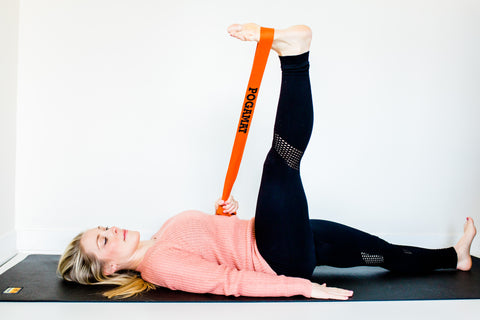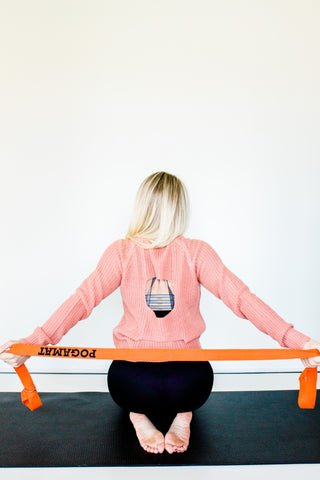
Happy Monday and here we are.... already into April! If you are sitting there going, "Where in the world does the time go?!", we hear ya! For that reason (and so many others) we think is it so imperative to carve out some time each day to practice being present in the moment. You can do this by taking just 15 minutes out of your day to focus on your breathwork while simultaneously practicing a few yoga poses and taking a break from the hustle and bustle of everyday life.
Syncing the body and the mind is essentially what yoga means, also translating to "union" or "to join". However, what if we interpreted that in another way and decided to "join" our bodies with a powerful tool that could offer even further relief and satisfaction? Maybe you have come to know and love Pogamat's products in the form of both yoga and cardio mats, but did you know that we also sell shoulder straps (otherwise known as yoga straps)? Now, you may be thinking... ok, I have the strap and it's great for carrying my bag, but what's so special about this device other than for that purpose? Maybe you have never even heard of a yoga strap before! That is totally ok! We are here to enlighten you!
If you weren't aware that a yoga shoulder strap could be used to aid in your yoga practice or, if you aren't utilizing it in that way, we may have just changed your life. No, really though! Hear us out. Your yoga strap can offer even more benefits to your already satisfying yoga practice and we are here to tell you how.
To dig in, I first want to just say that I am a huge believer in utilizing yoga props (blocks, straps, bolsters, blankets... the list goes on) to deepen your asana practice. I always encourage my yoga students to have props at their side because I feel that it is better to have it and not need it than need it and not have it. When it comes to props, there is often a negative connotation around them (often referred to as a “modification”) but in reality, props are here to help you increase flexibility, stabilize joints, and create space where needed. They can help you get to places that you may not otherwise venture and in a safe and supported manner.
Using a yoga strap is a good way to incorporate self-help into your yoga practice. It can be compared to having a yoga teacher “assist” you in a pose, or otherwise further guide and deepen the stretch. No matter what your level of experience is with yoga, a strap can provide useful help on support, alignment, and posture Always listen to your body, and let your body open up in its own time. Just be mindful not to pull yourself into any postures with force and to listen to your body.
Let’s get in to six stretches where you can utilize the yoga shoulder strap open up your muscles soothe any muscle tension and tightness and take your yoga practice to the next level. These are all supportive stretches, allowing you to go deeper into a stretch than you normally would and are great for post-workout recovery by helping you return your body into a healthy alignment.
Pose 1: Side Stretch
Benefits: arms, shoulders, and the sides of your body. If you are one who works hunched over a computer all day, this one is for you and can even be done right from your desk.
Step 1: Either standing hips width distance apart or kneeling on your shins, take a hold of your strap a bit wider than shoulder width
Step 2: Reach your arms directly up over your head so that your palms would be facing forward.
Step 3: Engage your core, elongate your spine, root down through your seat, stretch over to one side, stretching and opening the shoulders and each side of the body. Switch sides.
Tip: if you are kneeling, keep your hips grounded and in line with one another as you stretch each side.

Pose 2: Shoulder Opener
Benefits: This one is fairly obvious… shoulders!
Step 1: Standing or kneeling, grab strap in each hand holding the strap with the hands wide enough so you can move the strap forwards and backwards without bending your elbows.
Step 2: extend arms straight out in front of you.
Step 3: Take it slow, and do not force anything, reach arms overhead and take them behind you, as far as they will go. Remember, the slower the better.
Pose 3: Cow Face Pose
Benefits: Shoulders and triceps
Step 1: Begin seated or standing. Hold your strap in your right hand, lift your arm until your elbow is by your ear, letting the strap dangle behind you.
Step 2: Reach behind with your left hand and grab the belt, gently pulling on both sides of the strap as you feel your shoulders opening.
Step 3: After about 10 to 15 pulls, switch arms.
Tip: This bind will feel different from one side to the other and one might be more challenging than the other. Eventually (with practice), your hands will be able to inch closer and closer together on the strap until they clasp!

Pose 4: Half hero forward fold
Benefits: hamstrings and quadriceps (with the stretch)/ loosens a tight lower back (with the fold).
Step 1: Begin on the floor, one leg folded beneath you and the other extended in front of you. If you are using a block, place it beneath the glute of your extended leg and against your opposite ankle.
Step 2: Wrap your strap around your hands until you feel tension build in the back of your thigh.
Step 3: You can stay here if you're feeling a deep enough stretch, or you can begin to fold your upper body over your extended leg.
Step 4: Hold for 15 to 30 seconds, then switch legs.
Tip: You may need to place a yoga block beneath the glute of your extended leg depending upon your level of flexibility.

Pose 5: Reclining Hand-to-Big-Toe Pose
Benefits: plantar fascia and back hamstrings
Step 1: Lay down on your back, extending one leg out to the end of your mat and bend the opposite leg, drawing your thigh into your torso.
Step 2: Loop the strap just above the arch of your foot and extend it upwards, flexing your toes down at your face.
Step 3: Hold one side of the strap in each hand. Keeping both sides taut, pull down more on the left hand, then right, so the strap rubs against your plantar fascia.

Pose 6: Outer Hip Release/Supine Twist
Benefits: opens the outer hips, quads, hamstrings, upper and lower back, and shoulders.
Outer Hip Release:
Step 1: Follow steps from option 4
Step 2: shift your leg out to the side
Step 3: remember to stay grounded through your left side as well.

Supine Twist:
Step 1: Drag your right leg over to your left side (the right hip will lift off the ground).
Step 2: Extend it fully to the side, holding it a few inches off the floor.
Step 3: Keep your upper body flat on the ground and reach your right arm in the
opposite direction.
Step 4: Hold for 15 to 30 seconds, then switch sides.

So there you have it, 6 poses you should be taking a few minutes to do each and every day. While these are simple stretches, your strap can be used in so many ways including standing balancing poses, binds, arm balancing poses, etc. Bottom line, don't ignore the real function of your yoga strap. It can be used in a variety of ways. As you can see, some of the benefits include lengthening your hamstrings, working your quads and being able to hold poses for a longer period of time.
Want an added benefit? Use your yoga strap to neatly and efficiently transport your yoga mat in a tidy manner. If you don’t already utilize your yoga shoulder strap in this way, you are missing out! If you ride your bike to yoga class, take public transit, walk or jog to class, or are simply slinging it into the back of the car, you need to carry your mat and keep it neatly rolled up.
Here is what our Pogamat Shoulder Strap offers:
- Included “O” ring allows you to attach keys or water bottle.
- Keeps the mat rolled tight.
- Great for stretching and yoga poses.
- Ships in 1-2 business days.
Go ahead, try it out for yourself. Trust us, you will not be disappointed!
Leave a comment
Comments will be approved before showing up.
Also in Pogamat Blog

Buy Yoga Mats That Last: The Durability and Design of Pogamat

At Home Workouts Comprehensive Guide Staying Fit in Your Living Room






